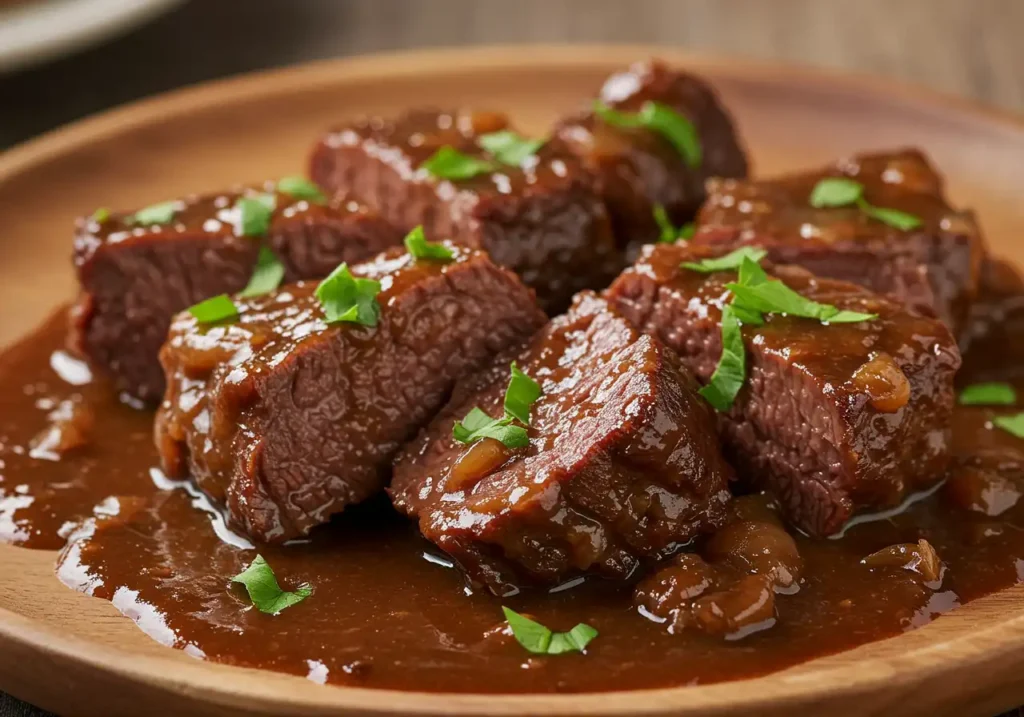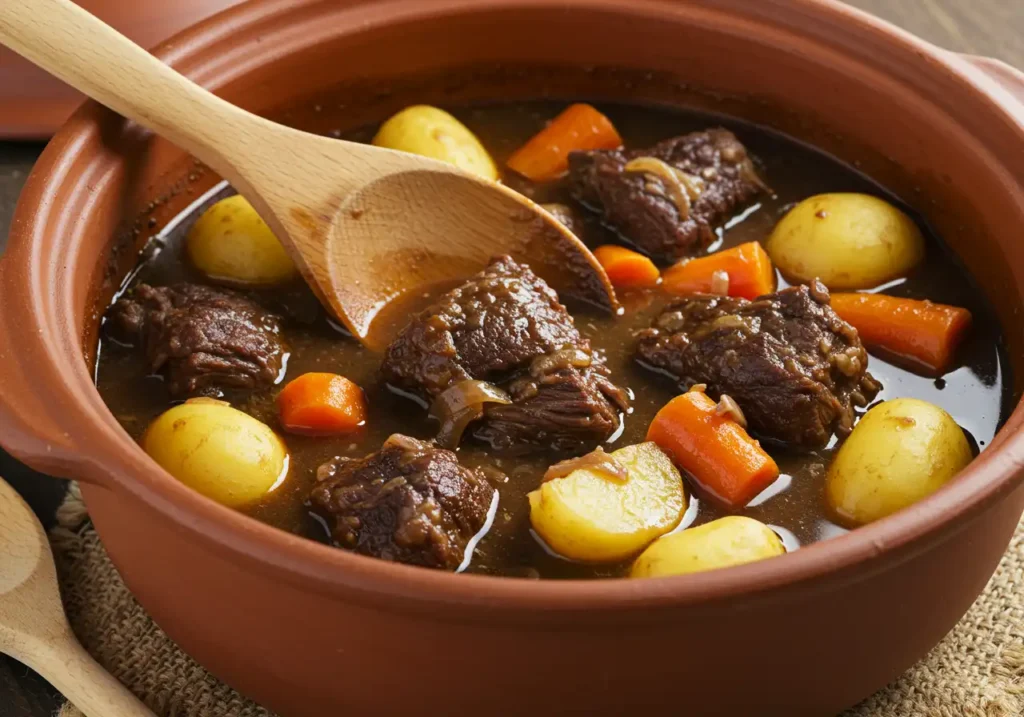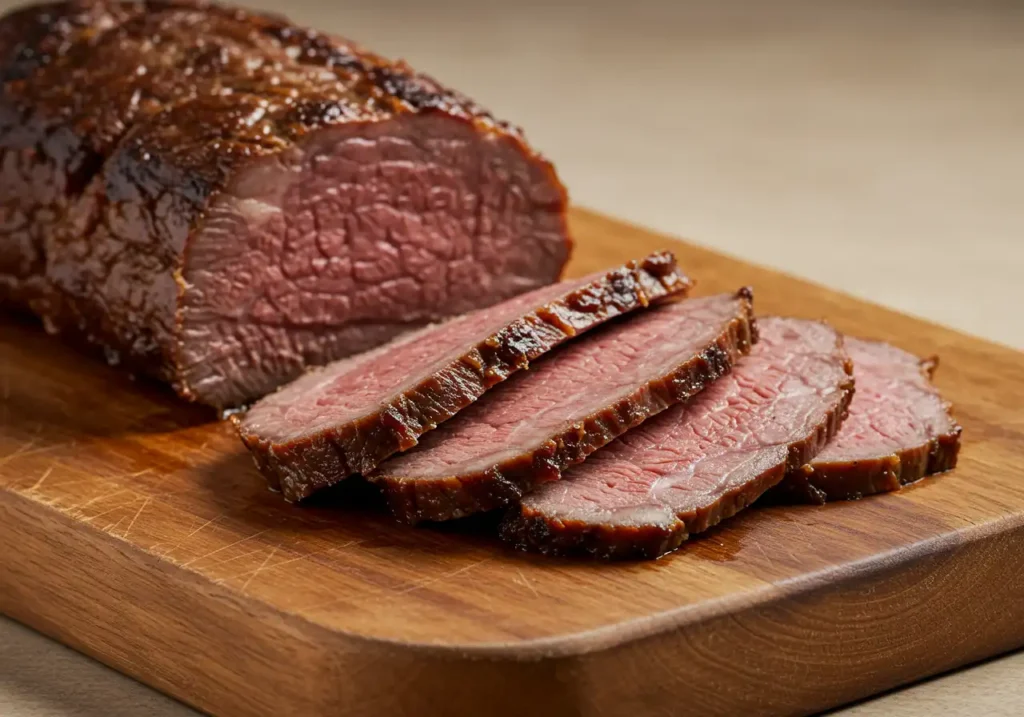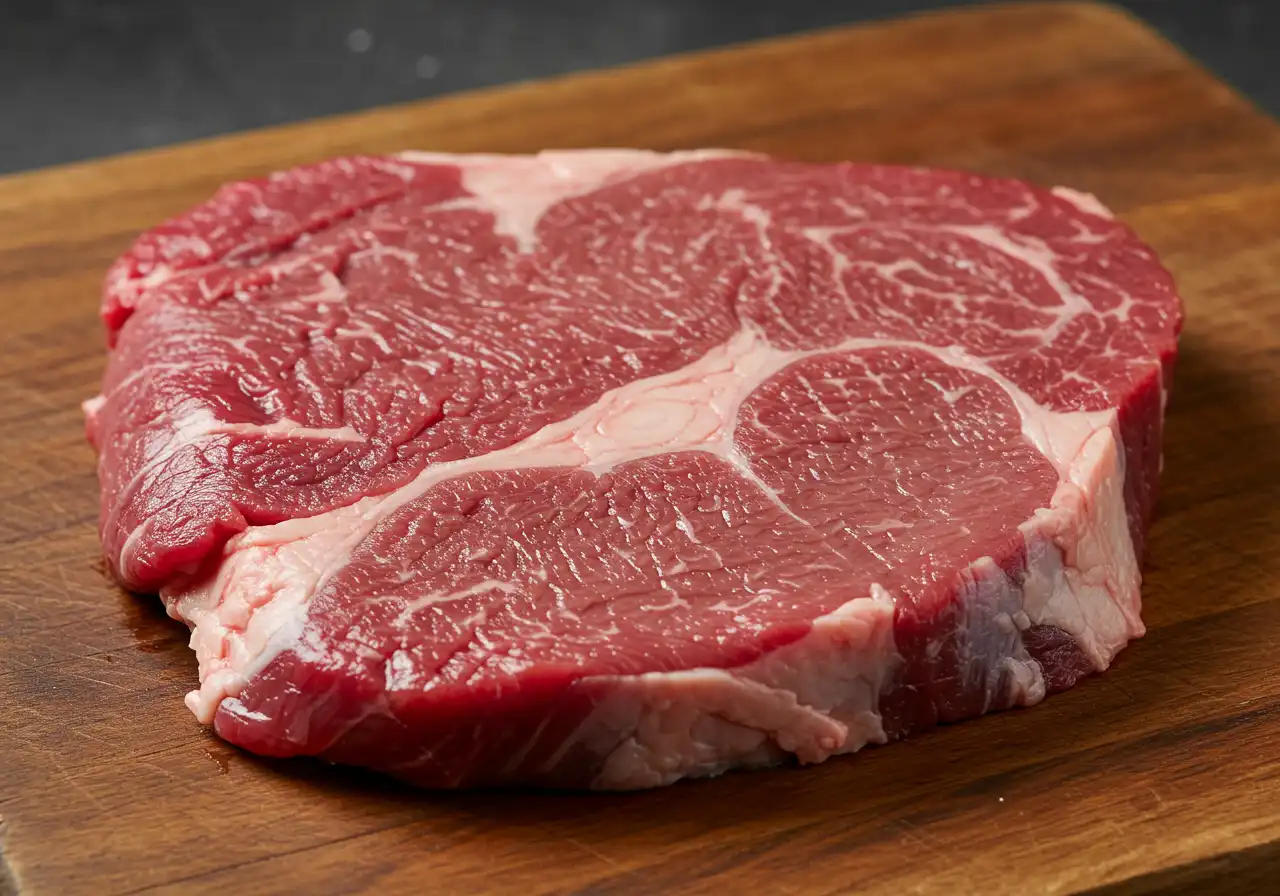Introduction to Is beef cheek slimy?
At the present time, many home cooks wonder about this intriguing cut of meat. The question often arises: Is beef cheek slimy? This article will address that concern head-on. It will also guide you through various aspects of beef cheek, including its texture, its best cooking methods, and whether it fits easily into your home-cooked meals.
We will discuss what makes beef cheek unique. We will explain how to prepare and cook it in ways that highlight its tenderness. In addition, you will find tips to ensure each bite is satisfying. Finally, you will see a humorous break in the middle, because who says cooking can’t be fun?
Keep reading to learn more about beef cheek, also known as a prized cut for slow cooking. In contrast to popular assumptions, beef cheek can be one of the most rewarding meats to prepare. Let’s explore the truth behind the slime myth.
Understanding Beef Cheek
Beef cheek is the facial muscle of the cow. It works hard throughout the animal’s life. Therefore, it contains a high amount of connective tissue, collagen, and robust flavor. This results in a cut that can become melt-in-your-mouth tender with proper cooking techniques.
However, many people question its texture. Does it feel gelatinous or slippery? They also ask, Is beef cheek slimy? Perhaps they have seen the slightly shiny surface when raw. This cut indeed has more connective tissue. It can sometimes appear slick when raw. Yet, when cooked correctly, it transforms into tender meat with a rich, velvety sauce.
The Reason for Its Unique Texture
- High Collagen Content: Beef cheek is rich in collagen. When simmered or braised, this collagen breaks down into gelatin. That creates a smooth, luscious mouthfeel, rather than an off-putting slime.
- Active Muscle: Because cows use these muscles so frequently, the fibers in beef cheeks become strong. However, gentle cooking leads to a rewarding tenderness that is perfect for stews or slow roasts.
- Moisture Lock: The muscle can hold moisture, especially during low and slow cooking. That can appear glossy, but it doesn’t mean it is unpleasantly slippery.
In other words, what you see is not exactly slime. Instead, it’s the natural sheen of a hardworking piece of meat. Once you master the cooking methods, you will likely savor beef cheek for its rich flavor and mouthfeel.
Is beef cheek slimy? – The Truth Behind the Question
Many culinary enthusiasts keep asking: Is beef cheek slimy? They might remember the first time they touched a raw piece of cheek. Perhaps they noticed a slippery surface. To be clear, this does not indicate spoilage or any unpleasantness. It’s mainly the connective tissues and collagen reacting with your touch.
Furthermore, when fresh and properly handled, beef cheek won’t emit a foul odor. Freshness is crucial. If you sense an off odor, the cut might no longer be good for cooking. Therefore, always practice proper food safety, including refrigeration and checking the sell-by date.
Debunking the Slime Myth
- Slime vs. Gelatin: Some people confuse natural gelatin with slime. When slow-cooked, gelatin enriches sauces and gravies, resulting in a silky finish.
- Proper Cleaning: Trim any excessive silver skin or membranes. That ensures a smoother texture and eliminates any chewiness.
- Cooking Temperatures: Braising beef cheek at a low temperature helps melt the connective tissue evenly. This results in tender meat without an overly slimy layer.
Appearance When Cooked
After a long simmer, you might see a glazed surface on your beef cheek. In contrast to real slime, that glaze is the result of dissolved collagen. This happens with many cuts of meat that are ideal for braising, such as shank or short ribs.
If the cut is fresh, the correct description is “gelatinous” or “silky,” rather than “slimy.” In conclusion, the next time someone asks you, Is beef cheek slimy? you can confidently say it’s all about collagen and the cooking method.
Why Choose Beef Cheek Over Other Cuts?
Beef cheek is often overlooked. However, it can produce mouthwatering results when prepared correctly. Its flavor is intense yet comforting. It is a dream for braised dishes. Here are some reasons to consider it:
- Budget-Friendly: Beef cheek is often more affordable than premium cuts.
- Tender Results: When cooked for the recommended duration, the meat becomes fork-tender.
- Deep Flavor: The muscle retains an abundance of savory flavor.
- Versatility: It can be used in tacos, stews, pot roasts, or shredded for hearty sandwiches.
In contrast, cuts like ribeye or tenderloin might cook faster but cost significantly more. Beef cheek, however, provides exceptional value once you learn the basic slow-cooking steps.
Common Cooking Techniques
You can transform beef cheek into a tender delicacy using several methods. Below are tried-and-true approaches:
- Slow Braise
- Sear the cheeks in a hot skillet with a bit of oil.
- Add aromatics like onion, garlic, and herbs.
- Pour in beef stock. Bring to a gentle simmer.
- Cover and braise in the oven at 300°F (approximately 150°C) for 3 to 4 hours.

- Slow Cooker
- Brown the cheeks on the stovetop.
- Transfer them to a slow cooker with vegetables and broth.
- Cook on low for 7 to 8 hours.
- Instant Pot or Pressure Cooker
- Use the sauté function to brown the beef cheeks.
- Add seasonings and enough liquid to cover at least half of the meat.
- Pressure cook for about 50 to 60 minutes, depending on thickness.
- Let the pressure release naturally for 10 minutes before opening the lid.
- Stove-Top Stew
- In a large pot, sauté onions, celery, and carrots.
- Add beef cheeks, stock, and herbs.
- Simmer gently for 2 to 3 hours, adding water as needed.
In the meantime, note that each approach aims to break down the collagen slowly. Because that collagen melts, the final dish tastes succulent rather than slimy.

Key Tips for Tender Beef Cheek
- Trim excess fat or silver skin to prevent chewy bites.
- Season generously with salt and pepper or your favorite rub.
- Sear all sides to lock in flavor and form a delicious crust.
- Use enough liquid or sauce so the meat doesn’t dry out.
- Resist the urge to rush cooking time.
In contrast to leaner cuts, beef cheek requires patience. Because it is so collagen-rich, you’ll want to give it time to become fork-tender.
Nutritional Data for Beef Cheek
To better understand what you are cooking, check out the approximate nutritional content per 3.5 oz (100 g) of raw beef cheek. This table helps you see how many nutrients you’re consuming:
| Nutrient | Amount per 100 g | % Daily Value* |
|---|---|---|
| Calories | 165 kcal | 8% |
| Protein | 20 g | 40% |
| Total Fat | 9 g | 12% |
| Saturated Fat | 3.5 g | 18% |
| Cholesterol | 65 mg | 22% |
| Iron | 2.1 mg | 12% |
| Vitamin B12 | 1.2 µg | 50% |
| Zinc | 4 mg | 36% |
*Percent Daily Values (DV) are based on a 2,000-calorie diet.
In addition, beef cheek provides essential amino acids. It also contributes vital minerals to your diet. Because of this, it can be a hearty and nutritious choice.
A Quick Joke to Lighten the Mood
Have you ever wondered why the beef cheek took so long to cook?
Because it needed time to chew things over before it got tender!
(Okay, we admit that joke might be a bit cheeky, but sometimes a little humor can brighten the kitchen!)
Flavor Pairings and Seasoning
Beef cheek pairs well with robust flavors. You can experiment with:
- Tomato-based sauces: Tangy tomatoes balance the richness of the meat.
- Root vegetables: Carrots, potatoes, and turnips add comforting sweetness.
- Herbs: Rosemary, thyme, and bay leaves enhance savory depth.
- Aromatics: Onions, garlic, and shallots provide a reliable flavor base.
- Seasoned stocks: Beef or vegetable stock to keep it moist.
Furthermore, you can add a splash of soy sauce or Worcestershire sauce for extra umami. Because the meat is quite rich, these tangy or salty elements help maintain balance.
Marinade Ideas
Although braising is the most popular method, you can marinate beef cheek to add layers of flavor. For instance:
- Soy-Lime Marinade
- 1/4 cup soy sauce
- 2 tablespoons fresh lime juice
- 1 tablespoon honey
- Garlic, crushed
- Herb Infusion
- Fresh rosemary, thyme, and parsley
- A few tablespoons of olive oil
- Salt and pepper
- Citrus-Garlic Rub
- Zest of one orange
- 1 clove minced garlic
- Pinch of chili flakes
In contrast to quick-cooking cuts, marinating beef cheek overnight is highly beneficial. The flavors will penetrate deeply by the time you braise or slow-cook the meat.
Side Dish Recommendations
When pondering, Is beef cheek slimy? you may also wonder about the best sides. The correct side dishes enhance the entire experience:
- Mashed Potatoes: Smooth potatoes complement the rich sauce.
- Creamy Polenta: Polenta’s creamy texture pairs well with tender beef cheeks.
- Roasted Vegetables: Adds color and extra nutrients.
- Simple Rice: Perfect for soaking up all the flavorful juices.
In addition, consider a crunchy green salad on the side. This provides a fresh contrast to the deeply braised meat.
Storage and Reheating
After cooking beef cheek, you may have leftovers. To store them safely:
- Let the meat cool to room temperature.
- Transfer to an airtight container.
- Refrigerate for up to 3 days.
Alternatively, you can freeze cooked beef cheek for 2 to 3 months. When reheating, do so gently in a covered pan with a splash of broth. That way, the meat stays tender.
In comparison to lean cuts, beef cheek tends to reheat better because of its higher collagen content. You will rarely end up with dryness if you follow proper storage methods.
Frequently Asked Questions (FAQs)
Below are several questions that people also ask about beef cheek. These questions arise from curiosity about the cut’s texture, preparation, and safety.
- What does beef cheek taste like?
Beef cheek has a deep, beefy flavor. It becomes especially rich when cooked slowly. Many describe its taste as savory, slightly sweet, and quite comforting. - Is beef cheek tough?
It can be tough if not cooked properly. However, low-and-slow methods break down the connective tissues. In the end, the meat becomes very tender. - How long should I cook beef cheek?
The duration depends on the method. For a braise, around 3 to 4 hours at 300°F (150°C). For slow cookers, 7 to 8 hours. For pressure cookers, around an hour. - Can I overcook beef cheek?
Technically yes, if you let it go too long without enough liquid. However, because of its collagen, it remains more forgiving than leaner cuts. - Is beef cheek slimy when boiled?
If simply boiled without seasoning or aromatics, it might appear slick. This is due to the collagen. Proper braising with flavorful liquids often results in a more appealing texture. - Can I stir-fry beef cheek?
Stir-frying is not recommended because the muscle fibers require long cooking to become tender. Quick methods generally yield chewy results. - How do I know if my beef cheek is fresh?
Check the color and smell. Fresh beef cheek appears deep red. There should be no sour or rotten odor.
Additional FAQs
Q: Is it safe to eat the gelatinous parts of beef cheek?
A: Yes, the gelatinous part is melted collagen. It is safe and adds a luxurious mouthfeel.
Q: Does beef cheek shrink a lot during cooking?
A: It can shrink somewhat, like most meats. The collagen renders during cooking, causing slight shrinkage. However, the end result is still substantial.
Q: Are there any special cleaning steps before cooking beef cheek?
A: Trim any tough membranes or excess fat. Rinse lightly if you prefer, then pat dry.
Q: Can I grill beef cheek?
A: Because of its toughness, grilling is not ideal unless you tenderize it first. Most chefs prefer slow and moist-heat cooking methods.
Q: Do I need to rest beef cheek after cooking it?
A: Yes, allow it to rest for about 10 minutes. This helps redistribute juices throughout the meat.
Q: Why is slow cooking essential for this cut?
A: Collagen-rich cuts like beef cheek require time to break down. Slow cooking ensures a more tender, succulent result.
Are beef cheeks good meat?
Yes. Beef🥩 cheeks are a delicious, collagen-rich cut. When cooked properly, they become incredibly tender and flavorful…
Why is beef cheek so expensive?
In some areas, beef🥩 cheeks cost more because they aren’t as widely available. Also, each cow yields a limited amount of cheek meat, which drives up demand…
Are beef cheeks a cheap cut?
Traditionally, they’ve been considered an affordable cut. However, in recent years, their growing popularity has sometimes increased their price. In contrast to prime steaks, they still can be a cost-effective choice…
Conclusion: Is beef cheek slimy?
In conclusion, Is beef cheek slimy? is a question rooted more in appearance than reality. The slippery surface often seen in raw beef cheek comes from collagen and connective tissues. When treated correctly, the beef cheek cooks into a silky, melt-in-your-mouth dish. There is no actual slime to worry about.

Therefore, do not let a passing concern stop you from enjoying one of the most flavorful cuts available. With proper handling, trimming, seasoning, and cooking, you can produce a tender meal that will leave your family and friends asking for more. To sum up, beef cheek is far from slimy when prepared well. It is a hidden gem that deserves a place in your culinary repertoire.
